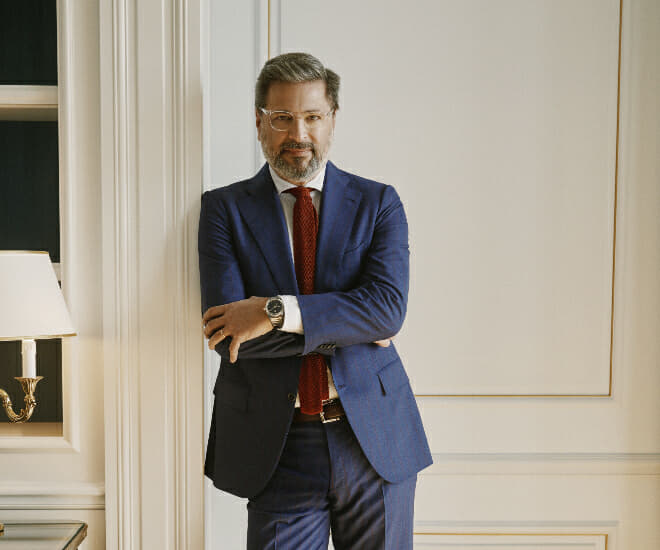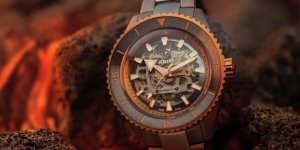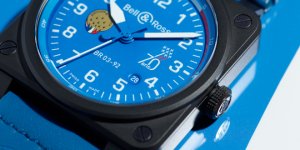Guido Terreni, CEO of Parmigiani Fleurier on the Star Piece: Tonda PF
Parmigiani Fleurier CEO Guido Terreni shares his insights on designing collections, and expounds on a few ideas about what makes the Tonda PF a watershed for the brand.

You may not believe me when I tell you that I have never interviewed a CEO in his office. That means outside of watchmaking too. Even during the various pandemic lockdowns, the interviews were done over the Internet but the CEOs themselves were working from home. Why should this be? Well, most watch brand bosses do the rounds with the press at watch fairs, when they visit markets, or on junkets. This all means that you are more likely to interview a watch brand representative at a hotel, in a hidden antechamber next to some mad party, or on a yacht in the South Pacific than you are to do the same at the manufacture.
The office space of a firm’s CEO is the inner sanctum — space that outsiders and those who do not have business with the top brass are excluded. Journalists are certainly not meant to be there, even watch specialists for whom someone like Parmigiani Fleurier CEO Guido Terreni is a star. Well, this interview is a first for this journalist, having taken place at Terreni’s office at the manufacture in Fleurier.
Our previous interview with Terreni — also our first meeting — was last year, after he took over as CEO. While changes in models and collections are quite normal in this type of situation, Terreni moved with great speed to launch the Tonda PF, a collection that has generated more buzz for the brand than any other I can recall. As for retail partners, a number of specialist titles have reported that the brand’s order books are full till at least next year, and possibly beyond for some models.
Given that the watch market is currently experiencing unparalleled growth (even as inflationary pressures grow, and Chinese demand remains contained within China), extraordinary demand for Parmigiani Fleurier watches might seem like a bit of non-news. On the contrary though, this brand, with what Terreni calls a quiet soul, does not grab much attention. Perhaps more than a few of you were surprised to learn the King Charles III has favoured a Parmigiani Fleurier since his days as the Prince of Wales. Of course, His Majesty is no IG superstar and cannot be expected to drive interest in a watch like social media messiahs can.
That might be as Parmigiani Fleurier prefers it, but its Tonda PF has proven to be such a hit that the force of its appeal is organically elevating the brand. Terreni attributes this, partly, to the enormous wellspring of goodwill that collectors and the industry have towards Parmigiani Fleurier. He even recalls that his former colleagues at Bulgari — where he headed up the watchmaking division for a decade — not only wished him well when he announced his departure, but also the brand. “I don’t know if it’s because Michel Parmigiani is so humble, and is a kind person, or maybe because we are not arrogant in pushing the product and distribution. Parmigiani Fleurier is a gentle brand.”
Parmigiani Fleurier is indeed an understated brand, and even its showcase at Watches and Wonders Geneva reflected this. Terreni is aghast at some of the excesses seen at the show, with “palaces” in place to create a spectacle, despite the fact that some of the brands in question cannot even take orders because they are struggling to meet demand. “I do not think I should put a lot of money into the stand at Watches and Wonders; I prefer to put it into the watches.” That said, the Tonda PF collection in particular is experiencing a surge in demand that puts the brand in a tight spot, which is where our conversation properly takes off.
The Tonda PF Is Doing Extremely Well, and We Hear You Are Sold Out for Everything You Presented Last Year. What’s the Situation Now?

Well, it depends on the reference; some new orders (for 2023) we can deliver by November, others by January (next year). As for the 2022 watches, we will probably deliver half (of all received orders) this year — we want to deliver more but the demand is overwhelming and we cannot keep up. Already before Watches and Wonders, we had great orders (for the Tonda PF from last year, which remains in the collection so continues to receive orders) and it has resulted in amazing growth… but it’s not a strategic way of doing scarcity on purpose. This is not who we are. We would love that everyone who wants a Tonda PF can get one, because we are the first who would like to see more of our watches on the wrists of our audience.
[This massive demand situation] is not a problem because it allows us to be more precise in our distribution. It allows us to do more and deliver watches to people [and partners] who are building the brand. So we will be reducing distribution but not in Singapore because we just started [again], now with Cortina and Sincere; I had a great meeting with Jeremy Lim (CEO of Cortina Watch) and he was extremely happy [with the partnership]… it was a very, very promising meeting [and we are] looking forward to doing business together in a very qualitative way. I was very happy to have met him with such an offer that he could understand. So in the future, [Parmigiani Fleurier] will be very coherent, very clean and not overdoing things [in the sense of the design and the substance of the watches]. So, not too many references, and that will keep the value of the watches very, very high.
Does Parmigiani Fleurier Factor After-market Prices Into This?
(Terreni pulls up a certain famous after-market dealer’s website to demonstrate where the Tonda PF is now, simultaneously demonstrating his point on the need to reduce some distribution!) So you see it is between 50-100 per cent above retail, and this is new for us. Parmigiani Fleurier always had a problem in keeping the value (over time), but that’s due to the fact that probably the brand got a bit lost in the last decade and didn’t have a true value proposition in terms of what was the vision. So my first job was really let’s put the values of the brand at the heart of the brand, [which is the watchmaking]. It is a lot about [watchmaking] competence, cultural colour, and knowledge, because of the restoration expertise of Michel Parmigiani himself. And that means there is a lot of understatement because Michel is extremely humble and not loud, not showy. So, these two values, knowledge and competence, have been interpreted (to match what) a gentleman today would like to wear.
And this is where the sports watch aesthetic comes in?

Of course, we are moving towards more informal dressing… From how we dress, how we behave when we are with people; there’s less etiquette now than there was before so it’s clear that a sporty watch has become the most coveted because it’s more or less adapted to being impeccably informal. In my opinion, the evolution of tastes in timepieces in the next decade will go towards watches that are more refined. I don’t see that big chunky watches have a big future so (brands) who have that as a core value proposition should be worried, okay. To have refined informality that is elegant and not loud, rich in watchmaking value like we’re doing is not easy because it’s not about extravagance. You have to be subtle and minimal in your ideas and execution, a bit like our GMT Rattrapante. It is so pure and so simple that you ask yourself, why did nobody do it before? This is in line with subtlety and elegance. It is understated because it is there, but not there, like the Grain d’orge (used for the quietest finishing touch with guilloche in the Tonda PF) you know. These are the values that are now behind the brand. To answer your question on value, this all adds up into an experience which preserves the value of the watches. The rest depends on how much we push…and how we bring the watches to the market.
Speaking of Subtlety, How Do You Manage That in Something Like the Tonda PF Skeleton?
When you look at skeleton watches in the market, they are not always designed as a whole watch. Too many designers of watches are looking at the watch in a fragmented way, not as a whole object. Often you have people who are designing the movement, who are only designing the movement. They are creating contrasts in the movement… so maybe the barrel is in gold and the bridges are nacre treated. And then you add the hands and now you cannot read the time — unless there is even more contrast. What we wanted was to have a very, very homogeneous background so you can read the time, because the beauty of the mechanics is there, but it is not that only the mechanics has to do all the work of making the watch beautiful. We have gone with something all-black; even the rubies are black, not to have a red disturbing you, when you read the time. In a blink of an eye. Our job is to make the experience of the customer seamless and comfortable in reading the time. And even in a complication or in a skeleton, you must never lose track of the fact that you have two hands that have to stand out more than all the rest of the information.
So Telling the Time Is Still Important, at This Level?

If you don’t read the time on your watch, why do you have it on your wrist? Okay, it is not the only reason… like you don’t buy a Ferrari to get you from A to B. Yes it can do that, but in a different way…something luxurious and refined. To have a watch that is your companion, you have to have pleasure in reading the time.
Finally Then, What Is Your Perspective on Design? Are Watchmakers Themselves Not the Best Designers of Watches?
True icons in watchmaking design are rarely created by those who are completely outside watchmaking. I don’t think that you can dissociate the design from the technical side, because you have to understand what is the potential of [any given watchmaking] technique. Okay, I think you have to blend [aesthetics and technical qualities] and each of them, these two souls, they have to understand each other. That doesn’t mean that they don’t have to challenge each other, but they have to understand each other. There has to be communication between them. The technical side should not impose a constraint — they have to work on the constraints that the designer sets. If a designer has an intuition, and the technical side says it’s not feasible, I don’t accept this. At the same time, the designer has to understand what the technical side can and cannot do. Both sides need to circumnavigate issues and find ways out [of creative roadblocks]. Maybe you make a concession here or there, but without taking away the soul of the designer’s intuition.
For more reads on leaders, click here.







